MARKETING
How to Structure a Marketing Dream Team for Any Size Company

As industries prepare to make changes to marketing personnel in the coming months, marketing department restructures are on the horizon. If you’re facing the pressure to grow revenue through marketing while keeping headcount to a minimum, you’re in luck.
We’ve cracked the code on how to structure a high-performing marketing team, and now, I’m going to share those insights with you.
In this post, I’ll walk you through what a marketing team structure looks like for small, midsized, and enterprise businesses, which structure will work best for you, and how to make your first or next marketing hire.
Marketing Team Sizes
First, let’s define what we mean by different company sizes. You may not agree with all of them, and that’s OK; we’re only using these numbers to establish a common lexicon in this guide.
- Small to Medium Sized Business (SMB): 5-100 Employees
- Midsized Business: 101-1,000 Employees
- Enterprise: 1,000+ employees (not including the massive Fortune 500 orgs)
Now that we’ve agreed on sizes, let’s talk about the marketing department structures you have to choose from.
How to Structure a Marketing Department
Here, I’m outlining three types of marketing department structures. These are dependent upon how large and how predictable your business is. Midsize companies with less predictable revenue forecasts may find a team structured by specific marketing disciplines will work better for them, while enterprise organizations with more predictable revenue forecasts can use a structure that has more opportunity for experimentation.
1. Marketing Department Structure by Discipline

Marketing departments that are structured by discipline are the most common. You’ll see these structures in midsized companies where marketing owns a revenue number and is responsible for driving leads and contributing to the pipeline of the business. These teams will collaborate to execute campaigns frequently throughout the year in order to hit the company’s revenue goals.
Here are some of the most common teams within the marketing department that are structured by discipline:
Social Media
Skills needed: Content creation, graphic design, social media management, project management, data analytics, and storytelling
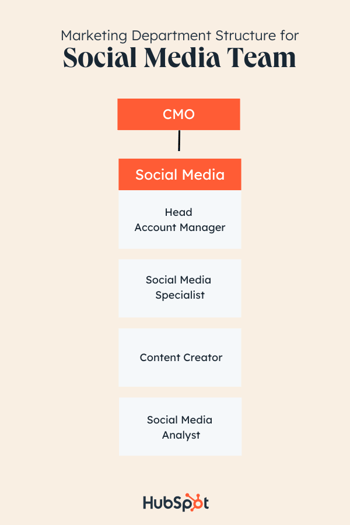
Your social media team will create and execute social media marketing efforts. This team will need to have knowledge of how to make engaging content to drive brand awareness, generate leads, and connect with audiences.
To properly perform these job functions, your social media team should have a working knowledge of creating, scheduling, and measuring the performance of social content.
Basic graphic design skills or knowledge of design tools like Canva or Adobe will be necessary for the content creation side, while social media management tools will help teams track performance, measure success, and schedule content.
Teams also need to be comfortable with customer service, as social media teams will be the ones responding to customers who engage through social media tags or posts. They will also be communicating to customers through content copy, blog posts, and comment sections, so an understanding of the company voice and ideal customer is key.
To help small teams, social media management software provides marketers with the tools they need to execute an entire social media strategy, such as the tools within HubSpot’s Marketing Hub.
Social media structure by team size:
SMBs with a team member dedicated to marketing should have a general comfortability with basic marketing practices and social media experience to build an online presence. If you can afford multiple marketing roles, start specializing in marketing functions like social media manager, which can be its own role.
Enterprise teams can structure their social media team by having specialists and managers to lead and oversee social media strategy, as well as roles for day-to-day social media activities, such as creating Instagram Stories and Posts, video editing for Facebook, and content management.
Potential roles:
- Head Account Manager
- Social Media Specialist
- Content Creator
- Social Media Analyst
Content Marketing
Skills needed: Writing, editing, organization, graphic design, project management, SEO, HTML, and storytelling
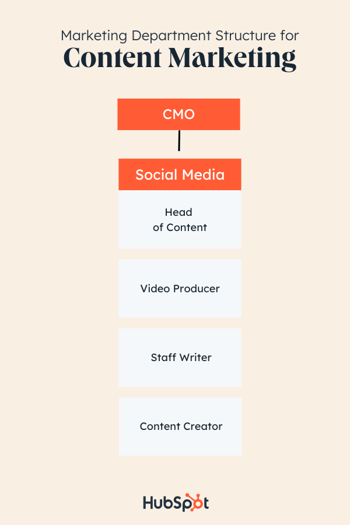
Your content creators will be the ones making sure your brand has enough content to tell a cohesive, compelling story. The content they produce will be useful in every facet of your marketing functions, from video to blog posts.
Content creators are skilled writers; they usually know how to create a solid blog post or webinar. They also have to be keen on editing — their blogs, videos, and social media content depend on it.
This team will be the go-to for the production of high-quality multimedia assets for your business, including podcasts, videos, ebooks, or other materials as needed. They may have to work on projects with other teams to make sure the messaging is correct, so your content creators should be ready to collaborate with others.
When building this team, make sure that your content creators are familiar with online management software, like HubSpot’s Marketing Hub. This makes their job easier. Instead of having to analyze data from multiple different sources, online software keeps all of that data in one place.
Content structure by team size:
In a startup, your content creation team might also be your social media and product marketing team. Though the roles are similar, content marketers need to have good organization and time-management skills in a fast-paced environment, so make sure the person you hire can work autonomously and in a team setting.
Hire a content creator who understands the story of your brand and brand voice. Their methods of sharing your voice through video, podcast, or ebooks should ultimately incentivize prospects to learn more about your business.
Larger companies hiring for a content creation team can hire by skill or by the needs of other teams. For example, Social Media Agencies need content creators for every client or group of clients.
Potential roles:
-
Head of Content
-
Video Producer
-
Staff Writer
-
Content Creator
-
Jr. Content Creator
Product
Skills needed: Research, analysis, strategic planning, cross-functionality, writing, customer service, a creative problem-solving mindset, technical knowledge, pricing strategy, and solving for the customer

This team is so important because they will communicate the features and benefits of your product to the customer. They’ll organize and drive the messages of a product and how it connects to your brand and the customer.
Product marketers identify target audiences to communicate with through product pages and ad copy. In addition, product marketers need to be star planners with keen attention to detail, as they will be planning campaigns for your products or services.
When you hire a product marketer, look for someone who demonstrates a deep understanding of overall marketing functions since, for start-ups, they might be your only marketer. They need to know how to research, analyze metrics, use that knowledge to plan future campaigns and target the customer’s needs in all of your business’s marketing materials.
In order to bring a product to life, a product marketer needs to know how to build an effective product page, and include content that will highlight that. They need to be able to present their strategies to other decision-makers and have plans for every strategy.
Product structure by team size:
The product marketer you hire as a small business owner is likely your only marketer, or the one leading marketing efforts with another team member. Hire someone with a background or demonstrated knowledge in writing, presenting marketing, and business.
Remember, the product marketer will communicate the product’s usefulness to customers, so the team member’s skills should be robust. If you are hiring for a larger team, then, you can have a little more flexibility. You can hire product marketers by product stack, so for instance, phones and personal laptops could be product stacks for a tech company.
You can structure your product marketing team by specialty, as well—a role based solely on developing copy or producing strategy, for example.
Potential roles:
- Brand Specialist
- Product Marketing Specialist
Search Engine Optimization
Skills needed: Writing, editing, problem-solving, experience with programming and technical thinking, analytics, spreadsheets, drive, and the ability to adapt

The SEO team will mainly be driving traffic to your webpages by optimizing content and ensuring your brand is aware of the keywords necessary to rank on the SERPs for topics related to your product or service. Occasionally, they’re also required to lend expertise to make business decisions. To accomplish these goals, SEO teams need to be made up of individuals with strong technical, programming, and writing skills.
Some SEO functions require writing, editing, and proofreading content to optimize it for audiences. This is where having a strong writing background will come in handy. SEO teams should be excellent problem-solvers and think about how to optimize content specifically for search engines.
These hires should be comfortable finding and implementing keywords, which will improve how high your business ranks on Google. They will also have to develop strategies for link building and develop a basic SEO protocol for the company.
In addition, SEO specialists should be fluent in analytics software to ensure they’re able to incorporate the lessons from those metrics into their overall strategy.
SEO structure by team size:
If you work for a small company, your SEO strategist might be melded with another role. If that’s the case, make sure that the SEO functions are being carried out by someone who has an understanding of analytics and optimizing content for search engines, as well as conducting thorough keyword research..
In other words, if they can’t speak Google or Bing’s language, they probably aren’t the right fit.
Comprehending analytics and optimizing content for SEO purposes will help your business rank on search engines and reach new prospects, or nurture leads until they’re ready to purchase..
For businesses that are large enough to build a team, hire for different specialties within SEO. For instance, you can hire for historical optimization, link-building management, or raising webpage traffic.
From there, you can hire project managers and team managers who are experts in the field of SEO and can offer seasoned advice to other team members, as well as manage multiple SEO projects at once.
Potential roles:
- SEO Strategist
- Senior SEO Strategist
- Historical Optimization Writer
Website
Skills needed: Programming, Creative Suite programs, interpersonal communication, Website and email design, user-experience orientation, content management software, understanding of web standards and best practices, and SEO

Of course, any business needs a website. And as your company grows, you may find the need to hire someone full-time to maintain your website. This team will be responsible for all things dot com, so you should hire a creative proficient in web design, web strategy, and optimization.
Your web design team will use their mastery of programming and web design tools to create and maintain the message your website is conveying. They will work closely with product marketing and content teams on web page execution, so the ability to collaborate across teams is essential.
They will be the point of contact for someone who runs into a problem on your website and should be able to fix any technical issues that may arise. You should trust your web design team to create a user experience that keeps customers coming back.
Website structure by team size:
The general function of a web designer is to make the web page experience seamless, optimized, and engaging for every visitor. They’ll use their expertise to deliver a delightful experience to customers who interact with your business’s web pages.
You can structure your web design by need, but if you can afford to build out an entire team, you can start hiring Senior Web Developers to bring your site up to current standards and maintain it, while Associate level hires can assist with those job duties as your design team grows.
Potential roles:
- Web Developer
- Senior Web Developer
- UX / UI Designer
- Front-end Web Developer
- Web Designer
- Visual UX Developer
- Graphic Design Specialist
Acquisition
Skills needed: Customer centricity, written and verbal communication, solution-driven mindset, and attention to detail

Though the entire marketing team should be customer-obsessed, your Acquisition team will be made up of those who live and breathe methods for delighting the customer through every step of their buyer’s journey.
Acquisition hires are the first contact with customers — they will introduce audiences to your brand. Your acquisition team will communicate to the customer as a representative and advocate for the company, and need excellent customer-facing skills and company knowledge to do so.
Another skill valued in an acquisition team is attention to detail; these teams have to be experts in how products can help customers and capitalize on little moments that can enhance the customer experience.
The biggest question for an Acquisition team to answer is, “How can we delight the customer for every stage of the buyer’s journey?” and projects should reflect that. For instance, creating compelling content offers and tracking the performance of these CTAs will be essential for teams to make impactful strategies for driving growth.
Acquisition structure by team size:
For companies whose members don’t have the resources to build a full Acquisition team, make sure the team member you designate for acquisition can effectively communicate your brand. They should know how to delight customers every step of the way.
If you’re building a team for a larger company, hire for an Acquisition team with roles that are either exclusively customer-facing or exclusively non-customer-facing. Individual hires will be able to focus their job functions based on their interaction with customers.
For example, someone in a non-customer-facing acquisition role could have duties such as developing CTAs and content offers, so writing experience and an understanding of basic graphic design practices are critical. Customer-facing roles, then, will onboard customers, source and contact them, and identify and ease pain points they might have in their journey.
Potential roles:
- Lead Acquisition Specialist
- Customer Acquisition Specialist
- Content Acquisition Manager
2. Marketing Department Structure by Function

A slightly more traditional organization structure than the product structure above, the functional department structure leans heavily on the nuts and bolts of what makes great marketing work. This structure is similar to that of a bare-bones agency. It includes the pillars of taking a campaign from ideation to completion.
The functional marketing department structure works well for small teams that have limited headcount, resources, budget, and bandwidth. A team like this may be made up of a few full-time folks, part-time people, or it could be staffed completely by contractors.
For this structure, it’s common that your marketing department won’t own a revenue number and attribution won’t be too important (non-profits, very small service-based companies). If you’re a marketer who wears many hats and needs to hire folks with a similar work ethic, try this structure.
Operations
Skills needed: workflows, automation, written and verbal communication skills, problem-solving, team-building
Your operations team is responsible for managing the technical aspects of your marketing efforts. They’ll maintain the tech stack, handle marketing automation, manage email marketing workflows, and schedule and produce webinars.
Potential roles:
- Marketing Ops Specialist
- Email Marketer
Creative
Skills needed: graphic design, written communication, video production, photography, copywriting, front-end web design
The creative team is in charge of what your clients or customers see when they come across your brand. This team will take on graphic design, copywriting, video production, and some web design.
Potential roles:
- Graphic design
- Copywriter
Project Management
Skills needed: organization, project management, agile framework, budgeting, time management, written and verbal communication
To keep everything on schedule, within budget, and within scope, the project management team will step in. The individuals in this role will typically coordinate with both operations and creativity in order to keep things moving. They’ll manage vendors, contractors, and freelancers and also work as an event planner if needed.
Potential roles:
- Project manager
- Event planner
- Vendor manager
- Procurement specialist
3. Marketing Department Structure by Product

This marketing department structure organizes marketing teams by product. You might be thinking, “But marketing doesn’t own a product?” and that is true in the literal sense of the term, but when you think of marketing as a figurative product, you can better organize people around that product’s goals.
This approach works well for enterprise teams with predictable revenue patterns that don’t need to run frequent, stand-alone marketing campaigns to generate business. If there’s a proven marketing system in place to generate demand for the business, you can leverage a product-style marketing structure to grow in new, innovative ways. Global teams may also appreciate this structure because it reduces role redundancy across regions and gives hiring managers an opportunity to recruit talent globally.
There are three typical “products” within this type of marketing structure, plus one emerging “product” that can help differentiate your business if it makes sense within your industry.
Brand Team
Skills needed: strategic thinking, written and verbal communication, creativity, copywriting, social media management, customer journey mapping, and buyer journey mapping
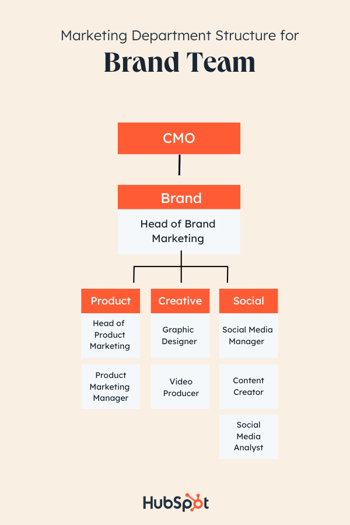
Brand includes everything about your business and distills it in such a way that potential, new, and existing customers can relate to it and external entities can appreciate it. When you’re thinking about building your marketing team around brand as a product, consider these ideas:
- Who would be responsible for the brand strategy?
- Who would be responsible for the way the brand looks, sounds, reacts, and shares ideas?
- Who would be responsible for influencing the brand in other parts of the business?
- Who would be responsible for the day-to-day championing of the brand?
Growth Team
Skills needed: Content marketing, content strategy, SEO, copywriting, web design, UI/UX design, and HTML
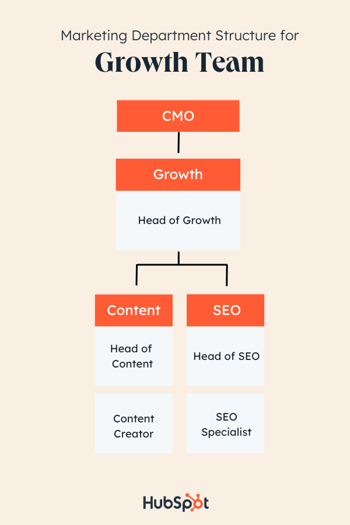
Growth marketing is responsible for generating demand and leads for the business either in existing or new markets. When you’re thinking about building your marketing team around growth as a product, consider these ideas:
- Who determines how much we grow, how fast we grow, and in which markets we grow?
- In which channels do growth opportunities exist?
- What is the short and long-term payoff of the growth strategy?
Acquisition Team
Skills needed: conversion rate optimization, UI / UX design, HTML, content development, content design, and data analysis
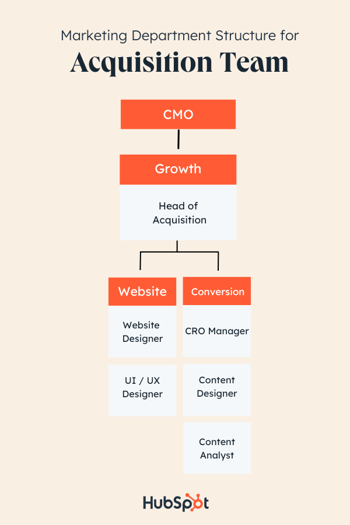
Once you’ve drawn the audience in and you’ve set growth goals, you’ll look to your acquisition “product” to secure leads and fill the pipeline for sales. When you’re thinking about building your marketing team around acquisition as a product, consider these ideas:
- Who would be responsible for the acquisition strategy?
- Who will be responsible for lead scoring and lead nurturing?
- How will the team attribute success?
Media Team
Skills needed: Video production, video editing, public speaking, creative writing, research, data analysis, and journalism
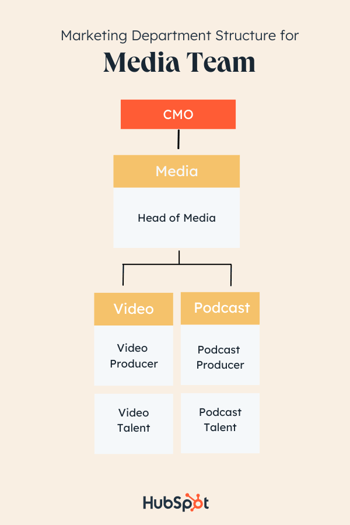
This emerging marketing “product” can and should encompass each of the three mentioned above, but it does so with an emphasis on the audience experience. Media products are best built when your brand product has a strong foothold in the market. When you’re thinking about building your marketing team around media as a product, consider these ideas:
- Is my company’s brand well-respected and sought after for thought leadership, publishing opportunities with highly-respected institutions, and generally regarded for setting the industry standard?
- Are both customers and non-customers engaging with existing marketing content from my company?
- Do the decision-makers within my industry consume media regularly enough to make this “product” worthwhile?
Types of Marketing Team Roles & Positions
Any successful marketing department structure needs a leadership and individual contributor hierarchy. How deep or wide you choose to organize your team is up to you, but here are the primary roles (in total or in part) you can expect to see in any marketing team.
Use this list to ascertain which roles you already have on your team, who in your company you can prepare for these roles, and who you should hire next.
Marketing People Leader Roles
1. Chief Marketing Officer (CMO)
Decision-making, owning the vision, and championing the team culture is the job of the CMO. This role sets the tone and standard for the entire marketing team and makes the call when the structure needs to change. The CMO reports to the CEO of the company with regard to how marketing is contributing to the business’s bottom line.
2. Vice President of Marketing
Setting the strategy for the marketing department at a high level is the responsibility of the VP. VPs may have ownership of specific products, functions, or disciplines which shapes the details of what this role looks like. They’ll have directors as direct reports and will interface regularly with skip-level reports.
3. Director of Marketing
You may see this role called a “Head of” instead of a director. The director of marketing is closely tied to their specific team which could be the entire marketing department at smaller companies or a subteam, like social media, for larger orgs. Their duties consist of putting the strategy from the VP into an actionable plan that managers can rally their teams around.
4. Marketing Manager
Marketing managers are people leaders on the front lines who manage individual contributors. Their day-to-day consists of weekly check-ins with direct reports and the director of marketing. They’re responsible for guiding their team toward meeting the goals and KPIs of the strategy.
Marketing Individual Contributor Roles
1. Marketing Consultant
A marketing consultant is typically an expert in a specific discipline like SEO or content creation. They are hired as a freelancer, contractor, or even on a part-time basis to help marketing teams reach their goals. Marketing consultants are critical to the mission of the team, but their expertise is needed in a limited capacity. If you don’t need a full-time hire on your marketing team, but would like to explore new channels, strategies, and tactics, consider bringing on a marketing consultant.
2. Principal Marketer
This individual contributor role is one of the highest-level full-time roles an individual contributor can attain in their career. These individuals are masters of their discipline rather than a jack of all trades. Internal and external team members look to them for guidance and industry-standard best practices. They may have more than a decade of experience in their discipline, but oftentimes, they have even more experience in other areas of marketing under their belt.
3. Senior Marketer
A senior marketer is one step below the principal marketer. They’re honing their skills in a specific discipline, but they may take on projects with a wider scope to build other soft and hard skills. They’re savvy with the latest trends in the marketing space and can serve as a mentor to junior members of the team.
4. Marketing Specialist
A marketing specialist plays more of a generalist role on the team. If the principal marketer is a master of one, the marketing specialist is a jack of all trades. They’re encouraged to explore a wide variety of marketing disciplines to gain an understanding of how tactics work together to achieve the strategy. From there, they’ll develop their skill set in one area of marketing that they’ll use to guide the rest of their careers.
5. Marketing Coordinator/ Marketing Associate
A marketing associate is an entry level position for recent graduates or new marketing professionals who want to change careers. They’ll take on ad-hoc assignments in various marketing departments and begin to build relationships with more senior team members. They may have an interest in one area of marketing, but they’ll work on several projects to become familiar with marketing as a whole.
6. Marketing Intern
The marketing intern is a temporary employee that is completing a degree of some kind, usually in an area of marketing or communications. They’ll explore various disciplines during their time in the company and learn how to apply the marketing lessons they learn in class to real-world situations. They may be offered a full-time position as a marketing associate or coordinator upon graduation.
How to Build a Marketing Team
1. Create a hiring strategy.
Before you can hire anyone, you need to put a strategy in place for building your marketing team.
You’ll need a clear understanding of your organization’s hierarchy. Consider how the roles within these teams overlap. For example, think about how the Acquisition and Content teams will work together.
2. Write the job descriptions.
After that, you can start to write the job descriptions and begin recruiting.
You can post jobs on your website, or on job boards like Indeed. When the applications begin rolling in, you can start to interview and vet your candidates.
It’s important that the people you hire mesh well with your team, so don’t hesitate to ask marketing friends for referrals.
Additionally, pay attention to LinkedIn connections while you’re vetting potential candidates in case you have a mutual connection. Leadership skills and the ability to fit in with your company’s culture are key here.
Plus, keep in mind that you want to hire experts. Your team should have experience and know what they’re doing.
3. Source candidates.
Before you begin recruiting candidates from external sources, look to your current team to see if anyone is interested in a marketing career. Not only does an internal candidate give you an opportunity to help someone progress their career, it saves you time and resources that you’d otherwise spend looking for external talent and getting them up to speed on your business.
If you’ve exhausted your internal talent pool or you need a more specialized skill set, there are several resources available to make this happen. Look to recruiters, headhunters, and candidate sources to help with the search. You can also browse candidate collectives or private membership groups like Black Marketers Association of America to list your job posting.
4. Extend an offer.
There’s a lot of discourse about how to interview for top marketing talent. How many interviews are too many? How do you know which candidate is the right fit? How long should the process take? We know that can be a challenge for small and large companies alike, so use this free resource to understand what you need to ask to evaluate your candidates objectively.
Once you’re ready to extend an offer, consider all the variables: their experience, their interview performance, their formal marketing training (courses, degrees, certifications), and any special skills that will help round out your team.
Use this information to craft a fair offer that aligns what they bring to the table with what the market demands. Be prepared for negotiations and questions about commonly overlooked benefits like insurance, on-call responsibilities, and professional development allowances.
5. Onboard the team.
After you’ve hired your team, you aren’t done building a great team. Building a great team continues long after the hiring process. For example, your onboarding process should help your employees understand the team culture.
Over time, building a great team is about documenting your goals, identifying gaps, and iterating on your process.
Build Your Marketing Dream Team
Hiring the best talent will require knowing the best skills for each role. Even if you’re hiring for a startup or small business and only have resources for 1-2 marketing roles at the moment, it’s still helpful to know the most transferable skills that will help you hire people who can grow into new roles in the future.
When you start with the right structure for your business type, put the right steps in place for hiring, and get the team aligned on a common vision, you’ll have a marketing team that will make even some fortune 100 companies envious.
Editor’s note: This post was originally published in November 2014 and has been updated for comprehensiveness.
MARKETING
Tinuiti Marketing Analytics Recognized by Forrester

Rapid Media Mix Modeling and Proprietary Tech Transform Brand Performance
Tinuiti, the largest independent full-funnel performance marketing agency, has been included in a recent Forrester Research report titled, “The Marketing Analytics Landscape, Q2 2024.” This report comprehensively overviews marketing analytics markets, use cases, and capabilities. B2C marketing leaders can use this research by Principal Analyst Tina Moffett to understand the intersection of marketing analytics capabilities and use cases to determine the vendor or service provider best positioned for their analytics and insights needs. Moffett describes the top marketing analytics markets as advertising agencies, marketing dashboards and business intelligence tools, marketing measurement and optimization platforms and service providers, and media analytics tools.
As an advertising agency, we believe Tinuiti is uniquely positioned to manage advertising campaigns for brands including buying, targeting, and measurement. Our proprietary measurement technology, Bliss Point by Tinuiti, allows us to measure the optimal level of investment to maximize impact and efficiency. According to the Forrester report, “only 30% of B2C marketing decision-makers say their organization uses marketing or media mix modeling (MMM),” so having a partner that knows, embraces, and utilizes MMM is important. As Tina astutely explains, data-driven agencies have amplified their marketing analytics competencies with data science expertise; and proprietary tools; and tailored their marketing analytics techniques based on industry, business, and data challenges.
Our Rapid Media Mix Modeling sets a new standard in the market with its exceptional speed, precision, and transparency. Our patented tech includes Rapid Media Mix Modeling, Always-on Incrementality, Brand Equity, Creative Insights, and Forecasting – it will get you to your Marketing Bliss Point in each channel, across your entire media mix, and your overall brand performance.
As a marketing leader you may ask yourself:
- How much of our marketing budget should we allocate to driving store traffic versus e-commerce traffic?
- How should we allocate our budget by channel to generate the most traffic and revenue possible?
- How many customers did we acquire in a specific region with our media spend?
- What is the impact of seasonality on our media mix?
- How should we adjust our budget accordingly?
- What is the optimal marketing channel mix to maximize brand awareness?
These are just a few of the questions that Bliss Point by Tinuiti can help you answer.
Learn more about our customer-obsessed, product-enabled, and fully integrated approach and how we’ve helped fuel full-funnel outcomes for the world’s most digital-forward brands like Poppi & Toms.
The Landscape report is available online to Forrester customers or for purchase here.
MARKETING
Ecommerce evolution: Blurring the lines between B2B and B2C

Understanding convergence
B2B and B2C ecommerce are two distinct models of online selling. B2B ecommerce is between businesses, such as wholesalers, distributors, and manufacturers. B2C ecommerce refers to transactions between businesses like retailers and consumer brands, directly to individual shoppers.
However, in recent years, the boundaries between these two models have started to fade. This is known as the convergence between B2B and B2C ecommerce and how they are becoming more similar and integrated.
Source: White Paper: The evolution of the B2B Consumer Buyer (ClientPoint, Jan 2024)
What’s driving this change?
Ever increasing customer expectations
Customers today expect the same level of convenience, speed, and personalization in their B2B transactions as they do in their B2C interactions. B2B buyers are increasingly influenced by their B2C experiences. They want research, compare, and purchase products online, seamlessly transitioning between devices and channels. They also prefer to research and purchase online, using multiple devices and channels.
Forrester, 68% of buyers prefer to research on their own, online . Customers today expect the same level of convenience, speed, and personalization in their B2B transactions as they do in their B2C interactions. B2B buyers are increasingly influenced by their B2C experiences. They want research, compare, and purchase products online, seamlessly transitioning between devices and channels. They also prefer to research and purchase online, using multiple devices and channels
Technology and omnichannel strategies
Technology enables B2B and B2C ecommerce platforms to offer more features and functionalities, such as mobile optimization, chatbots, AI, and augmented reality. Omnichannel strategies allow B2B and B2C ecommerce businesses to provide a seamless and consistent customer experience across different touchpoints, such as websites, social media, email, and physical stores.
However, with every great leap forward comes its own set of challenges. The convergence of B2B and B2C markets means increased competition. Businesses now not only have to compete with their traditional rivals, but also with new entrants and disruptors from different sectors. For example, Amazon Business, a B2B ecommerce platform, has become a major threat to many B2B ecommerce businesses, as it offers a wide range of products, low prices, and fast delivery
“Amazon Business has proven that B2B ecommerce can leverage popular B2C-like functionality” argues Joe Albrecht, CEO / Managing Partner, Xngage. . With features like Subscribe-and-Save (auto-replenishment), one-click buying, and curated assortments by job role or work location, they make it easy for B2B buyers to go to their website and never leave. Plus, with exceptional customer service and promotional incentives like Amazon Business Prime Days, they have created a reinforcing loyalty loop.
And yet, according to Barron’s, Amazon Business is only expected to capture 1.5% of the $5.7 Trillion addressable business market by 2025. If other B2B companies can truly become digital-first organizations, they can compete and win in this fragmented space, too.”
If other B2B companies can truly become digital-first organizations, they can also compete and win in this fragmented space
Joe AlbrechtCEO/Managing Partner, XNGAGE
Increasing complexity
Another challenge is the increased complexity and cost of managing a converging ecommerce business. Businesses have to deal with different customer segments, requirements, and expectations, which may require different strategies, processes, and systems. For instance, B2B ecommerce businesses may have to handle more complex transactions, such as bulk orders, contract negotiations, and invoicing, while B2C ecommerce businesses may have to handle more customer service, returns, and loyalty programs. Moreover, B2B and B2C ecommerce businesses must invest in technology and infrastructure to support their convergence efforts, which may increase their operational and maintenance costs.
How to win
Here are a few ways companies can get ahead of the game:
Adopt B2C-like features in B2B platforms
User-friendly design, easy navigation, product reviews, personalization, recommendations, and ratings can help B2B ecommerce businesses to attract and retain more customers, as well as to increase their conversion and retention rates.
According to McKinsey, ecommerce businesses that offer B2C-like features like personalization can increase their revenues by 15% and reduce their costs by 20%. You can do this through personalization of your website with tools like Product Recommendations that help suggest related products to increase sales.
Focus on personalization and customer experience
B2B and B2C ecommerce businesses need to understand their customers’ needs, preferences, and behaviors, and tailor their offerings and interactions accordingly. Personalization and customer experience can help B2B and B2C ecommerce businesses to increase customer satisfaction, loyalty, and advocacy, as well as to improve their brand reputation and competitive advantage. According to a Salesforce report, 88% of customers say that the experience a company provides is as important as its products or services.
Market based on customer insights
Data and analytics can help B2B and B2C ecommerce businesses to gain insights into their customers, markets, competitors, and performance, and to optimize their strategies and operations accordingly. Data and analytics can also help B2B and B2C ecommerce businesses to identify new opportunities, trends, and innovations, and to anticipate and respond to customer needs and expectations. According to McKinsey, data-driven organizations are 23 times more likely to acquire customers, six times more likely to retain customers, and 19 times more likely to be profitable.
What’s next?
The convergence of B2B and B2C ecommerce is not a temporary phenomenon, but a long-term trend that will continue to shape the future of ecommerce. According to Statista, the global B2B ecommerce market is expected to reach $20.9 trillion by 2027, surpassing the B2C ecommerce market, which is expected to reach $10.5 trillion by 2027. Moreover, the report predicts that the convergence of B2B and B2C ecommerce will create new business models, such as B2B2C, B2A (business to anyone), and C2B (consumer to business).
Therefore, B2B and B2C ecommerce businesses need to prepare for the converging ecommerce landscape and take advantage of the opportunities and challenges it presents. Here are some recommendations for B2B and B2C ecommerce businesses to navigate the converging landscape:
- Conduct a thorough analysis of your customers, competitors, and market, and identify the gaps and opportunities for convergence.
- Develop a clear vision and strategy for convergence, and align your goals, objectives, and metrics with it.
- Invest in technology and infrastructure that can support your convergence efforts, such as cloud, mobile, AI, and omnichannel platforms.
- Implement B2C-like features in your B2B platforms, and vice versa, to enhance your customer experience and satisfaction.
- Personalize your offerings and interactions with your customers, and provide them with relevant and valuable content and solutions.
- Leverage data and analytics to optimize your performance and decision making, and to innovate and differentiate your business.
- Collaborate and partner with other B2B and B2C ecommerce businesses, as well as with other stakeholders, such as suppliers, distributors, and customers, to create value and synergy.
- Monitor and evaluate your convergence efforts, and adapt and improve them as needed.
By following these recommendations, B2B and B2C ecommerce businesses can bridge the gap between their models and create a more integrated and seamless ecommerce experience for their customers and themselves.
MARKETING
Streamlining Processes for Increased Efficiency and Results

How can businesses succeed nowadays when technology rules? With competition getting tougher and customers changing their preferences often, it’s a challenge. But using marketing automation can help make things easier and get better results. And in the future, it’s going to be even more important for all kinds of businesses.
So, let’s discuss how businesses can leverage marketing automation to stay ahead and thrive.
Benefits of automation marketing automation to boost your efforts
First, let’s explore the benefits of marketing automation to supercharge your efforts:
Marketing automation simplifies repetitive tasks, saving time and effort.
With automated workflows, processes become more efficient, leading to better productivity. For instance, automation not only streamlines tasks like email campaigns but also optimizes website speed, ensuring a seamless user experience. A faster website not only enhances customer satisfaction but also positively impacts search engine rankings, driving more organic traffic and ultimately boosting conversions.
Automation allows for precise targeting, reaching the right audience with personalized messages.
With automated workflows, processes become more efficient, leading to better productivity. A great example of automated workflow is Pipedrive & WhatsApp Integration in which an automated welcome message pops up on their WhatsApp
within seconds once a potential customer expresses interest in your business.
Increases ROI
By optimizing campaigns and reducing manual labor, automation can significantly improve return on investment.
Leveraging automation enables businesses to scale their marketing efforts effectively, driving growth and success. Additionally, incorporating lead scoring into automated marketing processes can streamline the identification of high-potential prospects, further optimizing resource allocation and maximizing conversion rates.
Harnessing the power of marketing automation can revolutionize your marketing strategy, leading to increased efficiency, higher returns, and sustainable growth in today’s competitive market. So, why wait? Start automating your marketing efforts today and propel your business to new heights, moreover if you have just learned ways on how to create an online business
How marketing automation can simplify operations and increase efficiency
Understanding the Change
Marketing automation has evolved significantly over time, from basic email marketing campaigns to sophisticated platforms that can manage entire marketing strategies. This progress has been fueled by advances in technology, particularly artificial intelligence (AI) and machine learning, making automation smarter and more adaptable.
One of the main reasons for this shift is the vast amount of data available to marketers today. From understanding customer demographics to analyzing behavior, the sheer volume of data is staggering. Marketing automation platforms use this data to create highly personalized and targeted campaigns, allowing businesses to connect with their audience on a deeper level.
The Emergence of AI-Powered Automation
In the future, AI-powered automation will play an even bigger role in marketing strategies. AI algorithms can analyze huge amounts of data in real-time, helping marketers identify trends, predict consumer behavior, and optimize campaigns as they go. This agility and responsiveness are crucial in today’s fast-moving digital world, where opportunities come and go in the blink of an eye. For example, we’re witnessing the rise of AI-based tools from AI website builders, to AI logo generators and even more, showing that we’re competing with time and efficiency.
Combining AI-powered automation with WordPress management services streamlines marketing efforts, enabling quick adaptation to changing trends and efficient management of online presence.
Moreover, AI can take care of routine tasks like content creation, scheduling, and testing, giving marketers more time to focus on strategic activities. By automating these repetitive tasks, businesses can work more efficiently, leading to better outcomes. AI can create social media ads tailored to specific demographics and preferences, ensuring that the content resonates with the target audience. With the help of an AI ad maker tool, businesses can efficiently produce high-quality advertisements that drive engagement and conversions across various social media platforms.
Personalization on a Large Scale
Personalization has always been important in marketing, and automation is making it possible on a larger scale. By using AI and machine learning, marketers can create tailored experiences for each customer based on their preferences, behaviors, and past interactions with the brand.
This level of personalization not only boosts customer satisfaction but also increases engagement and loyalty. When consumers feel understood and valued, they are more likely to become loyal customers and brand advocates. As automation technology continues to evolve, we can expect personalization to become even more advanced, enabling businesses to forge deeper connections with their audience. As your company has tiny homes for sale California, personalized experiences will ensure each customer finds their perfect fit, fostering lasting connections.
Integration Across Channels
Another trend shaping the future of marketing automation is the integration of multiple channels into a cohesive strategy. Today’s consumers interact with brands across various touchpoints, from social media and email to websites and mobile apps. Marketing automation platforms that can seamlessly integrate these channels and deliver consistent messaging will have a competitive edge. When creating a comparison website it’s important to ensure that the platform effectively aggregates data from diverse sources and presents it in a user-friendly manner, empowering consumers to make informed decisions.
Omni-channel integration not only betters the customer experience but also provides marketers with a comprehensive view of the customer journey. By tracking interactions across channels, businesses can gain valuable insights into how consumers engage with their brand, allowing them to refine their marketing strategies for maximum impact. Lastly, integrating SEO services into omni-channel strategies boosts visibility and helps businesses better understand and engage with their customers across different platforms.
The Human Element
While automation offers many benefits, it’s crucial not to overlook the human aspect of marketing. Despite advances in AI and machine learning, there are still elements of marketing that require human creativity, empathy, and strategic thinking.
Successful marketing automation strikes a balance between technology and human expertise. By using automation to handle routine tasks and data analysis, marketers can focus on what they do best – storytelling, building relationships, and driving innovation.
Conclusion
The future of marketing automation looks promising, offering improved efficiency and results for businesses of all sizes.
As AI continues to advance and consumer expectations change, automation will play an increasingly vital role in keeping businesses competitive.
By embracing automation technologies, marketers can simplify processes, deliver more personalized experiences, and ultimately, achieve their business goals more effectively than ever before.
-

 SEARCHENGINES7 days ago
SEARCHENGINES7 days agoGoogle Core Update Volatility, Helpful Content Update Gone, Dangerous Google Search Results & Google Ads Confusion
-

 SEO6 days ago
SEO6 days ago10 Paid Search & PPC Planning Best Practices
-

 MARKETING5 days ago
MARKETING5 days ago5 Psychological Tactics to Write Better Emails
-

 MARKETING7 days ago
MARKETING7 days ago2 Ways to Take Back the Power in Your Business: Part 2
-

 SEARCHENGINES5 days ago
SEARCHENGINES5 days agoWeekend Google Core Ranking Volatility
-

 SEO6 days ago
SEO6 days agoWordPress Releases A Performance Plugin For “Near-Instant Load Times”
-

 MARKETING6 days ago
MARKETING6 days agoThe power of program management in martech
-
SEARCHENGINES4 days ago
Daily Search Forum Recap: April 15, 2024


![How to Structure a Marketing Dream Team for Any Size Company → Click here to download our free guide to hiring and training a team of all-stars [Free Ebook].](https://articles.entireweb.com/wp-content/uploads/2023/03/How-to-Structure-a-Marketing-Dream-Team-for-Any-Size.png)














